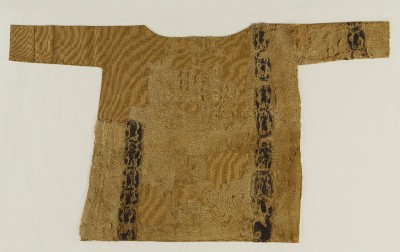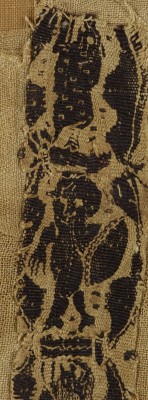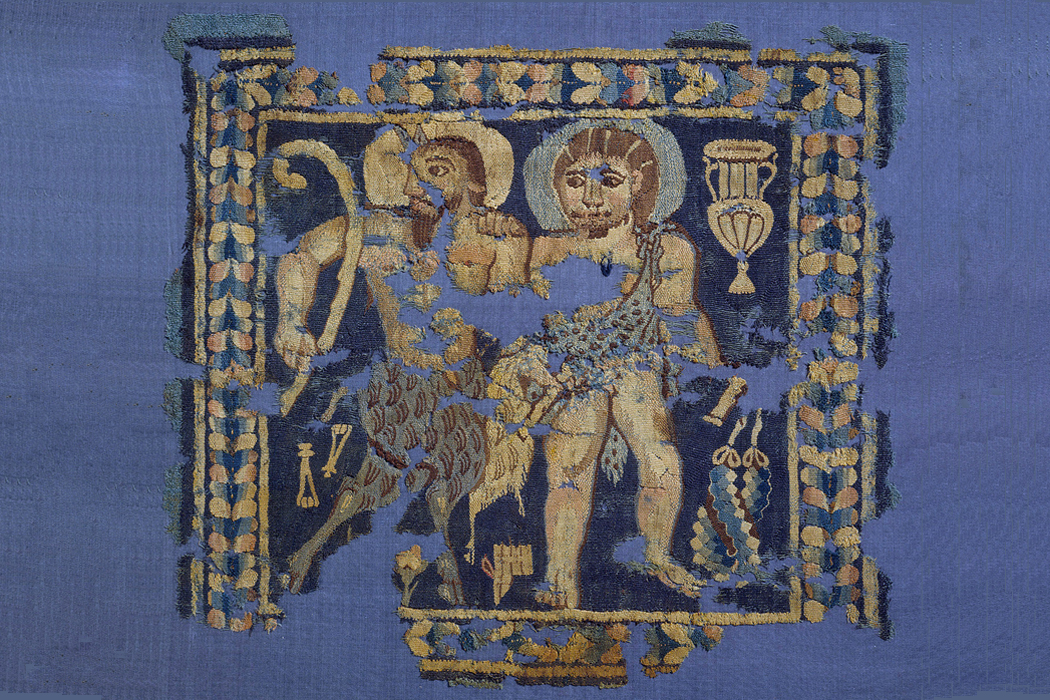The catalogue accompanying the exhibition on the Power of Textiles in Late Antiquity is both beautiful and informative
Designing Identity: The Power of Textiles in Late Antiquity
Edited by Thelma K. Thomas
Princeton University Press 2016
ISBN: 9780691169422”On my arrival, [Maximus] came out himself to meet me. But how changed his walk from the old erect and rapid gait; how changed the old frank regard and hearty voice! His dress, his walk, his humility, his pallor, his mode of speech—-all declared the churchman. And then his hair was short and his beard long; he had simple tripod seats; coarse Cilician hangings [sackcloth] covered his doors; the beds were featherless, the tables unadorned. His entertainment was as plain as it was kindly, with more vegetable than meat; if any richer dish appeared, it was brought not to him but to his guests.”
From letter by Sidonius Apollinaris to his friend Turnus c. 461 -7 Translation from Sidonius Apollinaris, Letters. Tr. O.M. Dalton (1915) vol. 2. pp. 3-47 ; Book IV
The letters of Sidonius Apollinarius are known to be full of descriptions delineating the different cultural practices, which one might encounter in Late Antique Gaul – Late Roman life in the countryside, barbarians smelling of the rancid butter in their hair or – in this case – the plain lifestyle of a Roman, who turned ascetic priest. Through these and other similar vignettes we get precious insights into the role, which textiles might have played in this period signifying the person and its status through its accoutrement.

However, knowledge about the the diverse ways in which all this might have played out, comes from the 100.000 – 150.000 precious pieces of textiles, which were excavated – robbed – from graves in Egypt in the course of the 19th and early 20th century, and which were later sold or donated to the large museums in Europe and USA.
It stands to reason that the main collections will be found in the large museums in Europe – Berlin, Mainz, Louvre, British Museum and V&A keep vast numbers of pieces wrapped in acid-free paper and stored under rigid climatic control. However, the collections in USA are not insignificant and should be kept in mind by any serious textile historian or archaeologist working on the material.
Currently (2016) an exhibition in NY is exhibiting some of these American held pieces of textiles and fragments thereof. In connection with this, the curator of the exhibition, Thelma K. Thomas, Associate Professor of Fine Arts, Institute of Fine Arts, has edited a very fine catalogue presenting and explaining the use and look of some of these treasures.
This is a very nice book, which anyone with a serious intention of experiencing and understanding the luxurious lifestyle of people in Late Antiquity will enjoy. The reason is, that textiles in numerous forms and qualities obviously played such an important role as literally couching the refined lives of the last Romans. The layout and the quality of the book obviously respects this.
Here we find cloaks and tunics presented – some embellished by appliques of silk or tapestry woven bands; but we also discover fragments of the ubiquitous hangings and curtains, which were later reused as shrouds or simply displayed in the tombs as wall-coverings. As any fine catalogue, the book holds a full inventory of what might bee seen, complete with thorough descriptions and explanations of materials, dates and production methods. But we also find vary valuable chapters on the collections in the museums, which have contributed so generously to the exhibition.

Of superb value, though, are the introductionary chapters, which outline the material meaning of textiles in Late Antiquity, the use of charms of all sorts on garments and the continuity of Late Antique patterns and motifs, witnessing to the continued cultural importance of wearing, inhabiting and demonstrating “Romanitas” to one’s social peers in a world, which sidonius and others thought was going awry. Here we encounter hangings and curtains depicting not only Pan, but also the ubiquitous Dionysian figures accompanied by nymphs and set in mythological scenes filled with birds, putti and the lush vegetation of the Nile River; but we also meet the people themselves flitting in and out of colonnaded porticos wearing their tunics (short for men and long for women and embellished with the clavis and the appliqued roundels functioning as important charms and spells.
One such example – not shown at the exhibition but found in the catalogue (p. 57) – is a child’s tunic from Brooklyn dated to the 5th – 6th century. Here “shield-carrying putti hunt rabbits scurrying up and down the front of the child, who wore the tunic”. The hare was associated with the cult of Osiris and a significant part of the funeral rites [1] Thus, the tunic is a very fine specimen witnessing to the syncretism of the newly Christianised Egyptians steeped in a world filled with ancient reminiscences.
Thus, the catalogue renders a service in between the traditional art-historical approach, where comparisons of motifs and form are ubiquitous, and the German preoccupation with the archaeological details of spinning, weaving, texture and dyes etc. Here we find at least the beginning of a social-historical exploration of the way in which textiles were used to design one’s identity in Late Antiquity.
It is a fact that the so-called excavations of the graves in the 19th and 20th centuries were often no more than plain grave-robberies: the aim was to find and present as many fabulous patterns as possible to the people involved in the Arts & Crafts Movement as well as making a business out of selling the pieces to museums and collectors in order “ to make an honest buck”. The frustration is of course that people in charge of the excavations unceremoniously disregarded information about where and under what circumstances the fabrics were found. Also, they threw anything away, which was not enough spectacular. Today, we know that fragments belonging to the same ensemble can be found in different collections all over the world. The challenge is that the circumstances of the find may no longer be reconstructed.
Nevertheless, it is obviously possible to get a glimpse of this context by once again mulling over the scraps, which we are left with. Congratulations are certainly due to the curator cum editor/author. Hopefully, though, research will continue down this road in years to come, while the international community get busy organising web-based catalogues spanning all the large collections making comparative cultural history really prominent. One such initiative, which might serve as a model is the Gothic Ivories Project housed at the Courtauld Institute.
Karen Schousboe
Notes:
[1] Discovering Late Antique Textiles in the Public Collections in Spain: an Interdisciplinary research project. By Laura Rodríguez Peinado, Ana Cabrera Lafuente, Ebrique Prra Crego and Luis Turell Coll. In: Greek and Roman Textiles and Dress: An Interdisciplinary Anthology. Ed. by Mary Harlow, Marie-Louise Nosch, Oxbow Books 2014, p. 364
FEATURED PHOTO:
A decorative panel from a furnishing, representing Pan and Dionysus, ca. 4th-5th century. Museum of Fine Arts, Bosto
